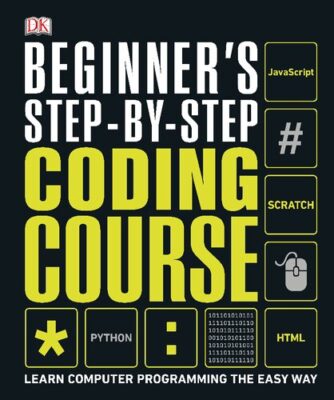Beginner’s Step-by-Step Coding Course: Learn Computer Programming the Easy Way
Pdf Book Name: Beginner’s Step-by-Step Coding Course: Learn Computer Programming the Easy Way
Author: DK
Publisher: DK, Year: 2020
ISBN-10, 13: 1465482210,9781465482211
Year: 2020
Pages: 360 Pages
Language: English
File size: 57 MB
File format: PDF,EPUB

Beginner’s Step-by-Step Coding Course: Learn Computer Programming the Easy Way
Books Details:
Absolutely! Here’s a beginner-friendly guide to learning computer programming the easy way. This will break down concepts into manageable parts and make it fun to learn.
### Learn Computer Programming the Easy Way
#### 1. Choose Your Language
– **Python**: Great for beginners, easy to read, and versatile.
– **JavaScript**: Essential for web development and interactive websites.
#### 2. Set Up Your Coding Environment
– **Install a Code Editor**:
– For Python, use [Thonny](https://thonny.org/) or [VS Code](https://code.visualstudio.com/).
– For JavaScript, you can use [VS Code](https://code.visualstudio.com/) with a browser.
#### 3. Understand the Basics
– **Hello, World!**
– Write your first program to print “Hello, World!”.
– Python: `print(“Hello, World!”)`
– JavaScript: `console.log(“Hello, World!”);`
– **Variables**: Store data using variables.
– Example in Python: `name = “Alice”`
– Example in JavaScript: `let name = “Alice”;`
#### 4. Learn About Data Types
– **Common Data Types**:
– **Integers**: Whole numbers (e.g., 5, -3)
– **Floats**: Decimal numbers (e.g., 3.14)
– **Strings**: Text (e.g., “Hello”)
– **Booleans**: True/False values
#### 5. Control Structures
– **Conditional Statements**: Make decisions in your code.
– Example in Python:
“`python
if age >= 18:
print(“Adult”)
else:
print(“Minor”)
“`
– **Loops**: Repeat actions.
– Example of a `for` loop in Python:
“`python
for i in range(5):
print(i)
“`
#### 6. Functions
– **What Are Functions?**: Reusable blocks of code.
– Define a function in Python:
“`python
def greet(name):
return f”Hello, {name}!”
“`
#### 7. Working with Collections
– **Lists**: Store multiple items.
– Example in Python: `fruits = [“apple”, “banana”, “cherry”]`
– **Dictionaries**: Store key-value pairs.
– Example in Python: `person = {“name”: “Alice”, “age”: 25}`
#### 8. Build Simple Projects
– **Calculator**: Create a basic calculator that can add, subtract, multiply, and divide.
– **To-Do List**: Develop a simple program to manage tasks.
#### 9. Explore Further
– **Version Control with Git**: Learn the basics of Git for tracking changes.
– **Online Resources**: Utilize platforms like Codecademy, freeCodeCamp, or Coursera.
#### 10. Join a Community
– Engage with coding communities on platforms like Stack Overflow, Reddit, or GitHub to ask questions and share knowledge.
### Tips for Success
– **Practice Regularly**: Consistency is key.
– **Start Small**: Break projects into smaller tasks.
– **Don’t Be Afraid to Ask for Help**: Use online forums and communities.
### Conclusion
Learning to code can be a rewarding journey. Start with the basics, build simple projects, and gradually tackle more complex concepts. Enjoy the process, and remember that every programmer started as a beginner!
If you want to focus on a specific topic or need further resources, just let me know!
DMCA Disclaimer: This site complies with DMCA Digital Copyright Laws. Please bear in mind that we do not own copyrights to these books. We’re sharing this material with our audience ONLY for educational purpose. We highly encourage our visitors to purchase original books from the respected publishers. If someone with copyrights wants us to remove this content, please contact us immediately. All books on the edubookpdf.com are free and NOT HOSTED ON OUR WEBSITE. If you feel that we have violated your copyrights, then please contact us immediately (click here).

